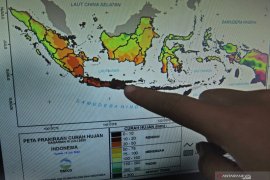In the last few days, floods have been reported in Jakarta, West Java, Central Java, East Java, East Nusa Tenggara, West Nusa Tenggara, West Kalimantan, North Maluku, Banten, and North Sulawesi, among others.Jakarta (ANTARA News) - As forecast by the National Meteorology, Climatology and Geophysic Agency (BMKG), the rainy season in Indonesia has peaked in February, triggering hydrometeorological disasters such as floods and landsides in several provinces.
In the last few days, floods have been reported in Jakarta, West Java, Central Java, East Java, East Nusa Tenggara, West Nusa Tenggara, West Kalimantan, North Maluku, Banten, and North Sulawesi, among others.
Floods in Jakarta since February 15, have hit 7,788 people, or 3,393 households, following incessant rainfall that caused the Ciliwung River to spill over its bank.
"Heavy downpour in upstream and central areas of Ciliwung River triggered flooding along its bank in Jakarta," Sutopo Purwo Nugroho, spokesman of the National Disaster Mitigation Agency (BPBN), said in a statement.
Flood waters, reaching a height of up to 1.5 meter, submerged several areas in East Jakarta, such as Cawang, Cibubur, Rambutan (Ciracas Sub-district), Cililitan, Kampung Melayu, and Bidakara Cina (Jatinegara Sub-district).
In Cirebon, West Java, floods have hit seven sub-districts, following incessant rains that caused several rivers to swell and overflow, leaving thousands of homes inundated.
Senior Commissioner Yusri Yunus, spokesman of the West Java Police Office, here, Thursday, confirmed the natural disaster in Cirebon on February 14.
The seven sub-districts were Lemahabang, Asjap, Gebang, Greged, Pangenan, Pabedilan, and Susukanlebak.
Landslides also affected several villages in the district, he said.
The West Java Police have deployed officers and rubber boats for evacuation in flood-hit villages.
Several schools were also flooded, thereby preventing students from attending them.
"Now, students are asked to help clear the mud and floodwaters from their schools," Samsul Huda, a teacher of Islamic junior high school, added.
In Pontianak, West Kalimantan, Incessant and heavy downpour triggered flooding in several parts of the West Kalimantan provincial capital of Pontianak.
Several roads were inundated, with floodwaters reaching heights of between 10 centimeters and 40 centimeters, Aswin Thaufik, head of the Pontianak disaster mitigation office, said on Feb 16.
Floods also affected several residential areas in the city. In the Danau Sentarum area, the floodwaters reached a height of up to 50 centimeters.
In North Sulawesi, floods hit Bitung City have forced 4,622 inhabitants to take refuge in higher grounds.
The floods have hit the sub-districts of Aertembaga, Maesa, North Lembeh, and South Lembeh, Head of North Sulawesi Disaster Mitigation Office Noldy Liow said on Feb 14.
Incessant heavy rain since Sunday had caused flooding that submerged 1,132 homes and a landslide that buried 30 homes.
In West Nusa Tenggara Province, floods hit seven sub-districts in Sumbawa District on Feb. 11.
As many as 5,232 houses in Lebak and Pandeglang Districts, Banten Province, had been flooded from Feb 9 to Feb 11.
Floods forced 4,510 inhabitants of Bitung in North Sulawesi Province to take refuge in higher grounds on Feb 12.
In Banten, floods submerged 1,908 homes in 65 villages in 17 sub-districts in Lebak District, caused by several rivers overflowing their banks.
"We are constantly distributing relief aid, particularly food items, to prevent flood victims from facing any shortage," Kaprawi, head of the Lebak disaster mitigation office, stated recently.
Most of the homes affected by flooding are located near riverbanks, he pointed out.
Floods also submerged 1,273.25 hectares (ha) of rice fields in Lebak, inflicting material losses worth billions of rupiah.
"We hope the Agriculture Ministry would help by offering compensation for the losses incurred, as the paddy fields were ravaged by floods. Hence, after receiving the aid, the farmers could speed up replanting," Itan Oktarianto of the local agriculture office, stated.
In addition to flooding, landslides were also reported to have killed 13 people and buried several homes in Kintamani Sub-district of Bali Province recently.
"The heavy rain that occurred since Thursday evening (February 9) has triggered landslides in three villages of Kintamani, Bangli District," Nugroho said in a statement on February 11.
Meanwhile, whirlwind damaged 924 homes in several sub-districts in East Flores District, East Nusa Tenggara (NTB).
The whirlwind hit the eastern part of Flores Island from February 6 to 12, Paulus Igo Geroda, head of the East Flores Disaster Mitigation Office, said in Kupang on February 17.
The disaster also damaged 19 school buildings, seven houses of worship, four clinics, 38 shops, and 34 other public facilities.
Larantuka town was the worst affected by whirlwind, as 654 homes located along the Larantuka beach were damaged.
The authorities will help rehabilitate the damaged buildings, he promised.
Meanwhile, Health Minister Nila F Moeloek has warned the public of diseases that spread during flooding in the current rainy season.
"During flooding, microbes causing diseases, such as diarrhea, typhus, and leptospirosis caused by rat droppings, are carried by flood waters," Moeloek said on Feb 14.
She also reminded the public to maintain cleanliness during flooding, which often triggers diseases.
In case of flooding, those affected by the disaster should take refuge in safe, clean, and dry places, the minister stated.(*)
Reporter: Fardah
Editor: Heru Purwanto
Copyright © ANTARA 2017











